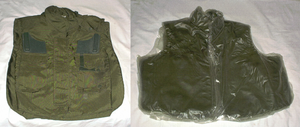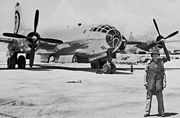
Flak jacket
Encyclopedia


History
Anecdotes describing garments designed to protect the wearer from penetrating weapons can be found far back into recorded history. Two types of protective garment from the American Civil War in the 1860’s had a basic design similar to the flak jacket or ballistic armor of modern times in that solid plates were used as the main ballistic protection. The "Soldiers' Bullet Proof Vest" was manufactured by the G. & D. Cook & Company of New Haven, Conn. It consisted of two pieces of steel inserted into the pockets of a regular black military vest. Versions for infantry weighed 3 ½ pounds while a version for cavalry and artillery weighed 7 pounds. They sold for $5-$7. A more medieval-looking type of armor was made by the Atwater Armor Company, also of New Haven. It consisted of four large plates of steel held on the body by broad metal hooks over the shoulders and a belt around the waist. The Atwater vest was heavier than the Cook models and cost about twice as much.During World War I, a number of British and American officers recognized that many casualties could be avoided if effective armor were available. Isolated efforts at developing armor were made, and soldiers could make individual purchases or efforts, but there was no armor issued to the troops. As it is today, issues of weight, cost, availability of materials and/or environmental stability complicated the issue of developing armor that would also be effective. For example, soft armor made of silk was tried on a small scale based on Japanese designs, but this material did not last well under the harsh environmental conditions.
The first usage of the term “flak jacket” refers to the armour originally developed by the Wilkinson Sword
Wilkinson Sword
Wilkinson Sword is a brand name for companies that make gardening tools and razors. Wilkinson Sword's origins are in the manufacture of swords. The company was founded in London in 1772. The brand is currently owned by Energizer Holdings. Past product lines have included guns, bayonets, and other...
company during World War II
World War II
World War II, or the Second World War , was a global conflict lasting from 1939 to 1945, involving most of the world's nations—including all of the great powers—eventually forming two opposing military alliances: the Allies and the Axis...
to help protect Royal Air Force
Royal Air Force
The Royal Air Force is the aerial warfare service branch of the British Armed Forces. Formed on 1 April 1918, it is the oldest independent air force in the world...
(RAF) air personnel from the flying debris and shrapnel
Fragmentation (weaponry)
Fragmentation is the process by which the casing of an artillery shell, bomb, grenade, etc. is shattered by the detonating high explosive filling. The correct technical terminology for these casing pieces is fragments , although shards or splinters can be used for non-preformed fragments...
thrown by German
Germany
Germany , officially the Federal Republic of Germany , is a federal parliamentary republic in Europe. The country consists of 16 states while the capital and largest city is Berlin. Germany covers an area of 357,021 km2 and has a largely temperate seasonal climate...
anti-aircraft guns' high-explosive shells (flak itself is an abbreviation for the German word for "anti-aircraft gun" (Fliegerabwehrkanone)).
The idea for the flak jacket came from Col. Malcolm C. Grow, Surgeon of the British Eighth Air Force. He thought that many wounds he was treating could have been prevented by some kind of light armor. In 1943 he was awarded the Legion of Merit for developing the flak vest.
Unfortunately, flak jackets proved to be too bulky for wear within the confines of the RAF's standard bomber aircraft, the Avro Lancaster
Avro Lancaster
The Avro Lancaster is a British four-engined Second World War heavy bomber made initially by Avro for the Royal Air Force . It first saw active service in 1942, and together with the Handley Page Halifax it was one of the main heavy bombers of the RAF, the RCAF, and squadrons from other...
. The Royal Air Force subsequently offered the jackets to the United States Army Air Forces
United States Army Air Forces
The United States Army Air Forces was the military aviation arm of the United States of America during and immediately after World War II, and the direct predecessor of the United States Air Force....
, which adopted them as a Defense Standard
Defense Standard
A United States defense standard, often called a military standard, "MIL-STD", "MIL-SPEC", or "MilSpecs", is used to help achieve standardization objectives by the U.S...
.
During World War II
World War II
World War II, or the Second World War , was a global conflict lasting from 1939 to 1945, involving most of the world's nations—including all of the great powers—eventually forming two opposing military alliances: the Allies and the Axis...
, flak jackets and steel helmets were worn by US Navy personnel on aircraft carriers during battle, since the ships and especially their flight decks offered little protection for their crew. The jackets were supposed to protect against shrapnel and heat.
Ballistic Protection
Col. Grow’s request to the Wilkinson Sword company was to develop a vest that could stop a .45 caliber round fired at close range. Although flak jackets offered some basic protection against small caliber bullets and shell fragments (which was obviously welcomed by their users), ultimately they proved to be less effective than hoped. Flak jackets are now generally considered to be inferior to body armor.It was claimed that the M-1951 field jacket could stop a 90 grain 7.62x25mm Tokarev pistol round at the muzzle of the gun. However, even the Vietnam era revised flak jacket was not really designed to stop an AK-47 round fired at close range. However, it did a good job of stopping shell blasts, rocket fragments, snake bites, fire ant bites, prickly thorn and slower bullets.
It was not until 1970 that the U.S. National Institute of Justice, which now publishes test and performance standards for body armor, began a deliberate program to develop body armor for law enforcement personnel that would be effective against specific threats that were common causes of officer injury and death. At the time that included .38 special and .22 long rifle bullets, in particular, and also bullets from 9 mm, .45, and .32 caliber firearms.
Materials
The flak jacketJacket
A jacket is a hip- or waist-length garment for the upper body. A jacket typically has sleeves, and fastens in the front. A jacket is generally lighter, tighter-fitting, and less insulating than a coat, which is outerwear...
consisted of manganese steel plates sewn into a waistcoat made of ballistic nylon
Ballistic nylon
Ballistic nylon is a thick, tough, synthetic nylon fabric used for a variety of applications. Ballistic nylon was originally developed by the DuPont corporation as a material for flak jackets to be worn by World War II airmen...
(a material engineered by the DuPont
DuPont
E. I. du Pont de Nemours and Company , commonly referred to as DuPont, is an American chemical company that was founded in July 1802 as a gunpowder mill by Eleuthère Irénée du Pont. DuPont was the world's third largest chemical company based on market capitalization and ninth based on revenue in 2009...
company); therefore, flak jackets functioned as an evolved form of plate armour
Plate armour
Plate armour is a historical type of personal armour made from iron or steel plates.While there are early predecessors such the Roman-era lorica segmentata, full plate armour developed in Europe during the Late Middle Ages, especially in the context of the Hundred Years' War, from the coat of...
or brigandine
Brigandine
A brigandine is a form of body armour from the Middle Ages. It is a cloth garment, generally canvas or leather, lined with small oblong steel plates riveted to the fabric....
. The first flak jacked weighed 22 pounds.
During the Korean
Korean War
The Korean War was a conventional war between South Korea, supported by the United Nations, and North Korea, supported by the People's Republic of China , with military material aid from the Soviet Union...
and Vietnam wars
Vietnam War
The Vietnam War was a Cold War-era military conflict that occurred in Vietnam, Laos, and Cambodia from 1 November 1955 to the fall of Saigon on 30 April 1975. This war followed the First Indochina War and was fought between North Vietnam, supported by its communist allies, and the government of...
, the flak jacket was changed and the manganese steel plates were replaced by other materials. The U.S. Army's vests (Body Armor, Fragmentation Protective, Vest M69) weighed under eight pounds and were made of several layers of ballistic nylon. The vests used by the U.S. Marines (Vest, Armored M-1955) weighed more than ten pounds and were a combination of ballistic nylon layers and fiberglass plates known as Doron. Doron was made of the fiberglass fibers in an ethyl cellulose resin under high pressure. It was named after then Col. Georges F. Doriot, then director of the Military Planning Division, Office of the Quartermaster General.
The generation of armor developed in the 1970s through the National Institute of Justice incorporated layers of soft armor in the form of DuPont’s Kevlar
Kevlar
Kevlar is the registered trademark for a para-aramid synthetic fiber, related to other aramids such as Nomex and Technora. Developed at DuPont in 1965, this high strength material was first commercially used in the early 1970s as a replacement for steel in racing tires...
fabric, which has since become synonymous with ballistic protection and a general term used for several similar (aramid
Aramid
Aramid fibers are a class of heat-resistant and strong synthetic fibers. They are used in aerospace and military applications, for ballistic rated body armor fabric and ballistic composites, in bicycle tires, and as an asbestos substitute. The name is a portmanteau of "aromatic polyamide"...
-based) materials.
See also
- Ballistic vest
- BrigandineBrigandineA brigandine is a form of body armour from the Middle Ages. It is a cloth garment, generally canvas or leather, lined with small oblong steel plates riveted to the fabric....
(an earlier form of vest, used to defend against swords, knives, etc.) - Buff coatBuff coatThe European Buff coat was an item of leather clothing worn by both the infantry and cavalry during the 17th century, usually worn under armour...
(an early form of ballistic vest, suitable for use only against pistol balls, but not musket balls) - HauberkHauberkA hauberk is a shirt of chainmail. The term is usually used to describe a shirt reaching at least to mid-thigh and including sleeves. Haubergeon generally refers to a shorter variant with partial sleeves, but the terms are often used interchangeably.- History :The word hauberk is derived from the...
(an earlier form of body armor, used to defend against swords, knives, etc.) - Mail (armour)Mail (armour)Mail is a type of armour consisting of small metal rings linked together in a pattern to form a mesh.-History:Mail was a highly successful type of armour and was used by nearly every metalworking culture....

